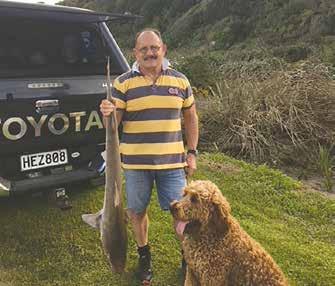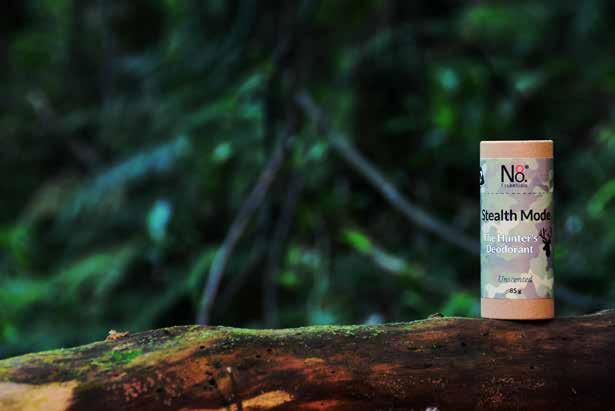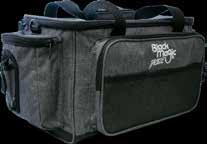












Trip sorted—ten of us travelled to Manapouri, where we boarded the boat taking us to the Manopouri Hydro Station at other end of the lake. We transferred all our gear to a bus then
traveling the famous Wilmot Pass to Deep Cove in Doubtful Sound. Here we boarded our live-aboard 21m boat , owned and operated by Steve Fishburn.
A collection of pig-hunting stories from veteran Kiwi hunter/ hunting author Kim Swan, whose nine previous titles were published by Halcyon Press. Each short chapter recounts an engaging pig-hunting tale full of action, humour, triumphs and disappointments.
Available at all good book stores and online Only $39.95
Heading off toward the coast, we made our way through the beautiful Doubtful Sound to the very wild and rough West Coast. We travelled south to Dagg Sound, arriving with a few

the league of the late Barry Crump and leading the pack of contemporary writers. Her unique yet natural writing style and whimsical narrative bring a charm to her stories that capture the hearts and minds of hunters and non-hunters alike-a true gift. Kim’s stories have proved a popular staple for The Fishing Paper & Hunting News readers for well over a decade.
gems and one of life’s lovely people to boot! This book deserves a treasured spot in your library; it won’t disappoint.”
Crimpy

“Had I lived long enough to read Kim’s work, I would have been impressed by her tight narrative, delightful prose and originality. I may have even learned a thing or two about spinning a good yarn. If I were alive today, and
Ernest Hemingwayvery green-looking faces on board.
freshened everyone up and, after setting the cray pots, we settled in for a good feed of fresh blue cod.
Over the next few days we
through the Dagg, Breaksea and Dusky Sounds. Some of the boys managed to score a few deer and divers were
The daily ritual of dropping the cray pots proved successful too.
second day off Dagg Sound produced my PB blue cod of 63cm! It was a pretty crazy
top and was full and fat. Certainly put a big smile on my face to match its size.
groper was pretty special, but the highlight of my trip would have to be trolling
were busting up all around
were amazing to watch and even better to hook up on; one took a good 15 minute
to land. At 15kg, one the come on board and, for me, a dream come true. The trip was well worth and hunting to match. Well planned, great food and loads of laughs. It was an be planning to do it again with my son Liam in a few years time, so if you ever get the opportunity to explore Fiordland—even better, get regret it!

The stressful university
ended. After months of hard work, long hours in the library and plenty of coffee to keep me going, I could
Until only a few hours into
Daniel Crimpmy well-deserved break, I received an urgent mayday call from Dad who was on his cronies around d’Urville Island. Rough seas and some questionable launching they were in desperate need of someone to show how it’s done. The forecast expected the weather to deteriorate allowing for only two more

touched base with Mum at home and made my way to French Pass, to meet the crew and set up for a big day on the water.
The rain held off and the clouds cleared to reveal an appetising sunrise. A steady swell rocked the boat as we steamed up to the top of d’Urville to target some big
Despite there being some sign on the sounder my enticing jig was snubbed by the kingies and I only which was gone as fast as it came. Luckily for me, the
was taken by the tax man right at the surface. With no success on the a slow jig, attempting to redeem myself with some snapper. This provided a bit more action as, within minutes, I was hooked

up. The light rod bent over and the reel screamed. Distinctive head shakes and strong runs indicated a nice snapper but with light gear, strong current, and 80 metres of line out, I had my work cut out for me. After a solid battle, the tug of war deteriorated and an orange glow emerged from the depths, a beautiful ten-pound snapper to show these old boys up. Despite snapper, the rest of the team

soon caught up. After me dropping a couple of nice snapper, they were quick to give me some stick.
The rush of snapper slowed as the top of the tide loomed.
up some fresh snapper for lunch and soaked in the sun before the radio crackled,
We raced around the corner to see one of the other boats holding up a nice 14-pounder.
It took a few attempts to get
Hospice nurses and volunteers working together can help patients remain in their own homes.
Nelson Tasman Hospice is seeking “Hunting Shooting Fishing” volunteers to join our patient support volunteer team .
the drift right but once we were set, it was on. The guys were quickly in too, landing a big trevally and a couple of snapper, but, while they dealt with snags and tangles, I quietly hauled in two more big snapper to solidify my place at the top of the leaderboard.
with a quick drift for blue cod, where I once again silenced the crowd and showed them how it’s done—job done!

2-4 hours during


The New Zealand Federation of Commercial Fishermen celebrated 70 years of advocacy and camaraderie at its conference and AGM in Blenheim on Thursday 1 June. Since 1952, the federation has brought together thousands of
across the country to advocate for industry and environmental issues that affect New Zealand’s waters, economies.
Federation President Doug Saunders-Loder says the grass-roots organisation plays an essential role in championing the country’s
“Over the years, the federation has pushed for the environment and
the industry, such as the creation of the 200 nautical mile exclusive economic zone and the creation of the Quota Management system in 1986, which has been about setting annual sustainability caps on catches.
“But federation membership is also an important way for people spending long, gruelling hours on the water to reconnect with friends across the country and feel like they are a part of something bigger.”
Minister of Oceans and Fisheries Rachel Brooking attended the event and organisation in her new
ministerial role. She spoke to the opportunities and both environmental and regulatory.
“It is tough for a number of seafood businesses right now, and I know that smaller face challenges like rising costs, the impacts of the way we use land on the marine
getting access to skilled
“Since becoming the minister, I have been pleased to see the effort selectively – whether you’re tweaking your gear
While the minister’s speech was respectfully received by those in the room, Doug
conference concluded with the federation’s annual charity auction to support the Shipwreck Welfare Trust, which provides immediate affected by shipwrecks and mishaps at sea around the coast of New Zealand. Thanks to the generosity of attendees, the auction raised a whopping $40,133.


took the opportunity to pressing concerns in his meeting with the minister following her speech. Doug says his job as president is
heard, and to make sure their insights and expertise make their way to decision-makers – to add a critical ‘frontline perspective’ to tomes of discussion papers.
The rest of the conference
discussions on the latest research and technology, updates from the under-35s Young Fish network and more.
The most animated session was the hour-long Q&A with representatives from Maritime New Zealand.
MNZ investigation into watchkeeping requirements for commercial and

recreational vessels was a hot topic. Of particular concern was rule 22.5, which states, “Every vessel must at all times maintain a proper lookout by sight and hearing as well as by all available means appropriate in the prevailing circumstances and conditions, so as to make a full appraisal of the situation
Not only does this
commercial operators who simply can’t afford to pay additional crew to maintain a watch 24/7, even when the vessel is anchored and at far less risk of collision, are subject to the same rule. Unless your boat is moored, someone is actively required to keep look-out. Certainly puts a wrench in the plans
of anyone planning an or family boating holiday, as anyone not maintaining a 24/7 watch would be in breach of the MNZ rule. The federation is keeping an eye on this developing regulatory situation and remains a staunch advocate for small inshore owner-operators and the water.
Whilst Southern Inshore mainly represents quota owners, the synergies between the issues related overlap with those of quota owners. Southern Inshore is a corporate member of the federation and up until recently Carol Scott, the CEO, was a long-term executive member with the close collaboration being maintained.
During the auction, federation member and trailblazing quota broker Donna Wells was awarded the Electronic Navigation Shield Award. Made of 2,000-year-old kauri and nearly a metre long, the trophy is given to someone who has gone above and beyond to support and promote the federation.
Donna has over 30 years of experience championing women in the seafood industry and promoting who catch the high-quality company, Finestkind Ltd.
“This award is special to me, given it comes from the heart of the industry and

recognises years of working with, and for, our wonderful – and often challenging –seafood industry and the

All in all, it was a rewarding event that highlighted the energy and forward-looking goals of the federation’s membership.

“With a new up-andcoming crowd of passionate see what the next 70 years

With exams looming and the slog of study week dragging me down, the sound of a quick getaway to the hills seemed like a dream to me, exactly what I needed but way out of reach.
That is until I got the message from Daryl
a hand on a wallaby cull with the opportunity of a cheeky fallow. There was no hesitation and I quickly made plans to head down for a night hunt that Friday with him. The day came before I knew it and as I pulled out onto the highway, away from Christchurch, I couldn’t help but grin.
Several hours later Daryl and I were heading out into the crisp moonlit night and heading for the hills, arm’s reach. The following few hours consisted of shooting wallabies and continuously busting deer from surprisingly long distances. The full moon was doing us no favours and it seemed the prospect of a deer for the freezer was a far-off dream, and to think
I thought this nighttime hunting was easy!
After a good slog we decided to head back and get some shuteye before going out for another look later in the night. After a few hours lying in bed dreaming of all the venison running around the hills above me, we were back out and into it. It didn’t take long before Daryl dropped a beautiful fat fallow doe, which we quickly dealt with before continuing our hunt through the night.
Several hours later after successfully adding to our tally of pesky wallabies we spotted what we thought may have been a lone buck and after a good stalk Daryl put it on the ground with a perfect shot, it was then just a matter of locating it.
I hopped the fence to head over to where the deer was and turned around just in time to see Daryl receive a very generous dosage of electricity right between the legs. Once I had stopped laughing and Daryl had gotten over the rather nasty surprise, we headed

down and came across his beautiful fat buck, which we gutted and left to retrieve the following morning. With two deer down and a good tally of wallabies we decided it was time to call it a night, this decision was quickly changed as we rounded the corner to see a large mob of deer sprinting in all directions. After a few relocations across the hill
position with two deer 150 metres above us.
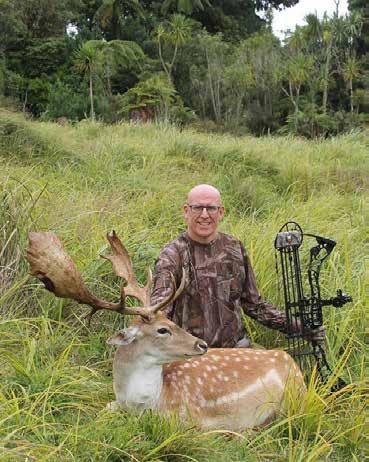



As far as we could tell through the thermal, they seemed to be small and young animals but venison is what I came for so I found as good a rest as I could on the edge of the side by side and took the shot, the deer dropped.
I grabbed the knife and the headtorch and sprinted up the hill but after a good search I couldn’t seem to
I could see was a big, bodied fallow further up the hill but that couldn’t possibly have been mine, the one I shot was just a yearling. I decided it was worth investigating though so I walked up to it and yelled back down to Daryl.
someone else has left one up
He promptly replied with something along the lines of, “That’s your deer you bloody
I think the sleep deprivation may have gotten to me as it was in fact my deer. What a way to wrap up a bloody

good night with my second ever fallow deer and a buck at that. I was going to be eating good for a while and

study, right after I’ve slept for 15 hours straight
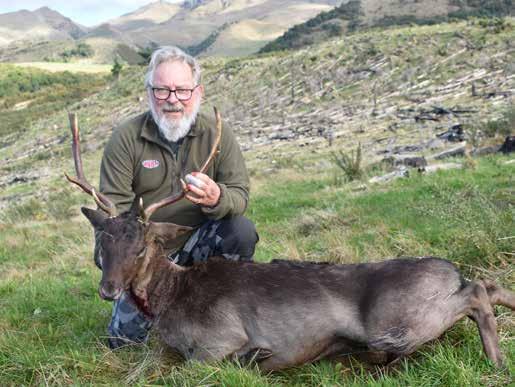
Early estimates show the recreational take from the recently closed Kaikōura pāua season was about a quarter of last year’s catch.
The two-month season ended on 15 June and was held in autumn rather than summer. The first season since the 2016 earthquakes was held from December 2021 to February 2022.
A second independent recreational pāua survey was undertaken during the season and those results are being discussed with local iwi, the Kaikōura Marine Guardians, and other key community groups and stakeholders.
Fisheries New Zealand Regional Manager Fisheries Compliance, Howard Reid says the timing of the
season made a di erence.
“The sea was cooler, and the weather unsettled from time to time, but it didn’t stop people from being able to catch a feed of pāua along the coast. We’re still analysing the results of the survey but at this stage about 11 tonnes of recreational pāua catch was taken during the 2-month season this year. This is significantly less than the 42 tonnes taken during the first season which lasted for three months.
It suggests that moving the season away from the peak summer holiday period, reducing the length, along with introducing new lower daily limits, have been really e ective at reducing the take and ensuring


sustainability for future seasons.”
Fishery O cers backed up by volunteer Honorary Fishery O cers patrolled the fishery every day, checking on catches and educating people on the rules and tools to use to harvest pāua. They found compliance with the recreational pāua fishing rules was high.
“More than 95 percent of fishers followed rules, which is encouraging. We had a strong focus on ensuring that pāua gatherers were not taking a daily catch for people who were not fishing, such as for friends on the beach. A lot of the pāua caught was also well above the 125 mm minimum length which is really encouraging for future seasons.
There were also new rules for the two-month season including lower bag and size limits for OaroHaumuri Taiapure. Overall, it was really pleasing to see the majority of people get behind the changes and stick to the rules,” says Howard Reid.
Meanwhile the Matariki long holiday weekend is approaching on 14 July and Fisheries New Zealand reminds all recreational fishers that the pāua fishery is closed and will remain closed until a new season is announced for 2024.
Fisheries New Zealand encourages people to report any suspected illegal activity through the Ministry for Primary Industries’ 0800 4 POACHER line (0800 47 62 24).


It’s late autumn and midafternoon as we arrived at the Havelock Marina after a long six-hour road trip from Christchurch. Finally, the OSPREY 565c was in the marina and it was time to cast off with the late afternoon sun behind us. The excitement and anticipation were beginning to build as we departed the marina, navigating the Havelock Channel and as we passed
we powered up and set course for Bulwer and the bach.
Next morning we decided to head out and explore the southern end of the Chetwode Islands, known as the nine pins and after a short 20 minute trip, we were anchored up and ready

cod competition was about to begin between the four of us.
Daiwa Ventio baitcaster and my TD Black Kohga 66HB rod, and both the rod and reel were working hard as the blue cod were constantly attacking my little 1 oz Inchiku jigs, which resulted in two good sized blue cod being landed.
After a quick change of lure to a 60gm Kabura and a move to the other side of the
rod and reel, the little Kabura was dropped overboard.
On reaching the bottom, suddenly, the rod bent over into a 45-degree angle as the gurnard took the Kabura. I began a steady lift and wind and was surprised at the size of the gurnard as it neared
the surface. we placed him on our New Zealand Fishing Comp measure mat and took a few photos to enter the DB Export Fishing Competition. We awoke next morning to a warm sunny day with wind and waterspouts in the bay. Over breakfast we rechecked our entry had been accepted and approved and as we scrolled down the list, to our surprise the ‘Great Gurnard’ was 25th on the leaderboard and a great start to our
It was time to head down to the beach and pick up the boat off the mooring and head out for another adventure. Today was going for Bulwer’s Big Blues.
National Volunteer Week, Te Wiki Tūao ā-Motu (1824 June) is a good time to honour New Zealand’s army of volunteer Honorary Fishery O cers who donate their time and expertise to keep fisheries sustainable, says Fisheries New Zealand’s regional fisheries compliance manager Howard Reid.
New Zealand’s Honorary Fishery O cers are volunteers who were critical to protecting the Kaikōura pāua from being overfished by inspecting catches and educating fishers on the rules during the recent recreational season.
The fishery was closed
in 2016 for five years to recover from the e ects of an earthquake that devastated the coastline and has recently recovered allowing for a two-month season which ended on 15 June.
“Fisheries New Zealand Fishery O cers patrolled the coastline with the dedicated help of our voluntary Honorary Fishery O cers (HFOs). The coast is vast, and we couldn’t have done it without them.
Our HFOs were along the coast, talking with fishers, checking their catch, educating people on the rules. They’re an invaluable asset and a big part of why

we’ve had an over 90% compliance rate,” Mr Reid says.
During the second pāua season, the area from Marfells Beach to Conway River was open for people to gather blackfoot and yellow foot pāua. There were also closed areas and customary management areas where di erent rules applied. HFOs were on the beat as often as possible.
“Like a lot of volunteers, our HFOs are selfless people. They do this work voluntarily because they care about their community – our shared fishing resources and protecting them so that future generations can enjoy putting fresh kaimoana on the dinner table. A big part of what they do is talking to people, answering curious questions, and explaining the rules,” says Howard Reid.
HFOs were first introduced in Auckland in 1967 as a way for people in the community to donate their time to help make a di erence to local fisheries. Fiftyfive years later there are about 180 HFOs working in communities around

uniform, and have a warrant under the Fisheries Act
These days each HFO contributes a minimum of 100 hours voluntary work a year to looking after recreational fishing areas. They’re put through intensive training, wear a


“Their work is critical to ensuring sustainability throughout all of our fisheries. HFOs are front and centre on New Zealand’s coastlines, conducting between 18,000 and 22,500 inspections each year. They’re incredible people
– all very passionate about protecting the resource, which is evident through the huge amount of voluntary work they do and some HFOs exceed that minimum of 100 hours,” says Howard Reid.
If you have questions about becoming an HFO, email HFO@mpi.govt.nz

Optimising device performance requires a basic understanding of display settings to provide the best image in the prevailing conditions.
The best image will vary depending on what is required of the device. For instance, looking-out for surface debris during marine navigation requires different settings to those required for rapidly spotting animals. While experienced users will have their own preferences,
broad selection of image options a little confusing. Let’s start with the weather and ambient temperature.
conditions
A thermal imager senses and renders an image based on the relevant temperature emitted by objects. The greater the temperature difference, the better the image. Usually, animals will be considerably warmer than their surroundings, so are easy to see. Image performance varies according to conditions.
High contrast scene
A high contrast scene has separation to stand out from surrounding objects. This occurs during daylight, when the sun’s heat warms some objects more than others, and lasts for well after sunset when these objects slowly release their heat.
Low contrast scene
A low contrast scene occurs late at night when object temperatures have
equalized, especially in the presence of dew and after rainfall. Cold air temperature increases the rate of cooling.
Visual barriers
High humidity, mist and rain are thermal barriers that degrade image quality, as is foliage that absorbs heat making warm objects
foliage.
Brightness and contrast are the two settings that predominantly alter an image to provide optimum viewing. High quality
AMOLED displays can be adjusted to enhance image quality, while low quality displays will struggle. A display is only as good as the thermal sensor and processor that produces the signal, so consider a thermal imager as a system with interdependent components.
The following settings make a good starting point to suit prevailing conditions.
Adjust brightness to suit light conditions, for instance, increase brightness in sunlight and reduce brightness in dimmer surroundings. Reduce brightness as much as possible at night to reduce eye fatigue and night blindness.
Contrast
Increase or reduce contrast according to the conditions. If image detail is important, use a lower contrast. A higher contrast is better for

spotting animals because it increases separation between objects with lower temperatures and objects with higher temperatures. Both brightness and contrast need to be adjusted to obtain the desired image because one setting affects the other. A little experimentation at home will pay dividends when out
These are the White-hot and Black-hot settings. White-hot displays warmer objects as brighter and is the best setting for spotting living beings, that boldly stand-out against their surroundings, which are darker due to having less heat. Black-hot renders warm objects as darker than their surroundings.
Black-hot forms an image with greater edge detail because light-spill falls into warm objects, while Whitehot spreads edge detail outwards. For this reason, military thermals are used in Black-hot mode for better
darkness however, Black-hot renders most of the image as bright, which can be a little uncomfortable. Being able to toggle between White-hot and Black-hot is a good way of spotting and identifying objects.
All colours rendered in an image that is formed by light outside of the visible spectrum are pseudocolours that add colour separation to an image comprised of multiple levels of grey. Colour pallets are a personal choice based on the viewers own preference and visual needs, such as colour blindness.

• are light. Animals stand out more easily especially at night when the surroundings are cool.
• are dark. Best for a clear image.
• Red-hot: same as white
yellow. I use this in the evening because it causes less eye fatigue.
• Rainbow: from cool to hot blue, green, yellow, red.
• Ultramarine: blue image, to red.
• Violet: violet image, warm areas are yellow and white.
Conclusion
If you are new to thermal imaging, start by experimenting with contrast and brightness in different lighting and weather conditions while observing the way these settings affect the image. Get used to accessing and changing the settings in the dark or for

A Pulsar thermal has the following colour pallets. The emboldened settings are my favourite:
display red. Animals are highlighted in red that stand out well against a grey image.
• image with warm



• and white. This is my favourite setting for prolonged viewing at night with minimum eye fatigue.
must never be overlooked is to ensure that the diopter ring on the eyepiece is correctly adjusted for a clear image. This may seem obvious, however…. For more information on thermal imaging, visit www.advancedoptics.nz



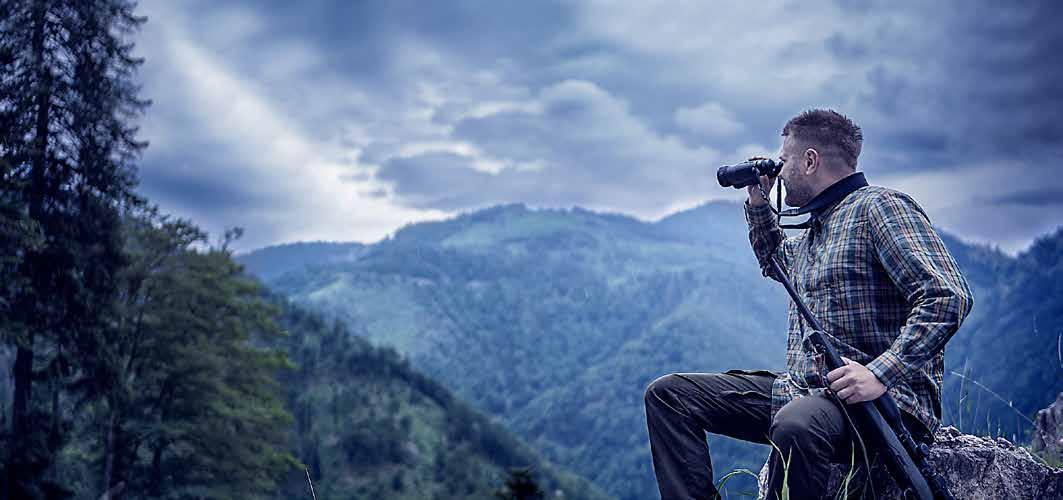

The Pulsar Axion series is a compact and versatile thermal monocular, available with choice of Lynred sensors.
AXION 2 XQ35 PRO / LRF
The new Axion 2 XQ35 Pro has a Lynred 384x288 / 17µm sensor with the highest sensitivity of <25mK for outstanding performance through rain, mist and foliage.
AXION 2 XG35
640x480 / 12µm sensor that produces outstanding image resolution, zooming
The LRF version has an accurate 1000m
Horizontal Distance settings
Professionals choose
and viewing comfort of a classic binocular with the advantages of a thermal imager.
Viewing with both eyes is more natural and causes less eye fatigue. A single accurate distance information
MERGER LRF XP50
Lynred 640x480 / 17µm sensor has and sensitivity of <25mK for better performance through rain, mist and foliage.
MERGER LRF XL50
professional 1024x768 / 12µm sensor for incredible resolution, zooming capability
and affordable thermal monocular, while pocket while walking.
AXION XM30F
Lynred 320x240 / 12µm sensor delivers
for most thermal imaging situations such as stalking, pest control and property security.
Pohnpei is the capital island state of the Federated States of Micronesia and my new home. Situated 10° above the equator in the the second wettest country in the world. Mountainous terrain is covered in lush rain forest but also bathed in sunlight. The average monthly temperature
Sean Ryanfor the garden! Surrounded by dense coral reefs broken by narrow passes out to the deep blue water beyond, the shoreline is embraced by regal ancient mangrove forests with rare sandy beaches or open rocky shoreline.
Locals have navigated river channels through the mangroves out to the inner and outer reefs forever, to feed families and supplement
their income. They troll, use drop stoning techniques. are hand-lines, regardless of the size of the species targeted.
Fishing has always been intrinsic to the island way of life, for sustenance, local trading and, in recent times, to help fund the country levies. There are between six
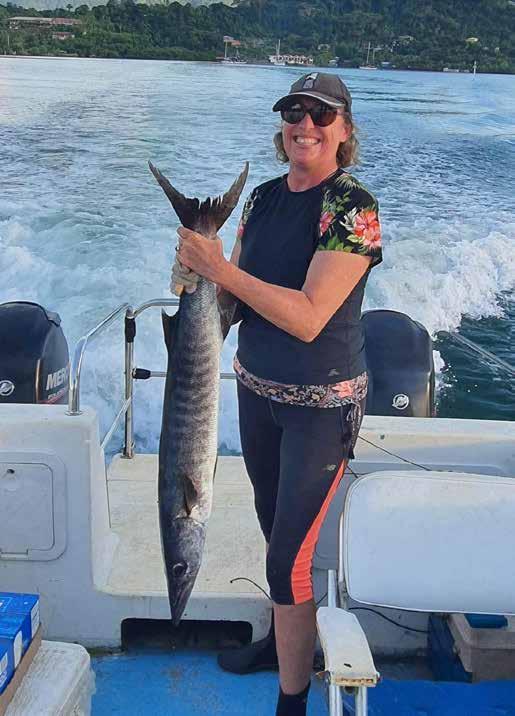

to eleven large commercial transporter mother ships always moored inside the reef to receive tuna from the seiners.
not necessarily the biggest as tasty. The huge range of and readily available. I have not described as “great for sashimi,” with the other main preparations being baked, steamed, cooked over open
here and I could spend most days smoking if I chose.
nearly always a mix of locals and ex-pats. Generally, the system that works well is we and fuel, while they bring their wealth of area and species knowledge, along with their traditional and learned techniques to ensure everyone goes home with a feed.
Their traditional drink is sakau, which is kava on steroids. Pounded root related to our kawakawa are wrapped in the inner lining
of the hibiscus bark and strained to give it its potency. It is everywhere on the island and is drunk in sakau bars, in community nahs and homes. It is an integral part of their culture and is always used to celebrate and, if you need to apologise or make a marriage proposal, you know you have succeeded if they drink the sakau you have provided! Unlike kava, if someone passes you a half coconut portion—you sip not scull—otherwise you
could end up in hospital, or at least feeling sick for several days like some overeager expats.
Islanders are lovely people who are honest, very helpful and happy. The standard of living is not very high, but their expectations are very simple and often non-materialistic, which complements their humility. Life is chilled and relaxing, sometimes a bit too much so, but that’s the way they roll—


It was a beautiful Wednesday morning at Bluff Wharf where my Grandpa Alistair and I had decided
home that day due to the teachers’ strikes so thought that there was no better way to spend the day than go
We had arrived at nine and high tide was at 11, so wasted no time setting an hour and a half with no

may of been because of a dredge working100 metres away from us, churning up the water. It kept doing laps but as soon as it left, we had fought pretty hard and I was
After that, it was like a and, in the next hour and a half, we landed six more
40 to 60cm mark. As well as inhaling the majority of the squid baits we popped out, we got cleaned out multiple times—“Day Of The let anything else get a sniff of the bait.
It was a pretty good day of spend time with Grandpa Alistair.

I wish I had cottoned on to drones sooner.
We work hard, play hard and we age. You can’t change that but you can get new parts—in some cases. I’m waiting for two knee replacements… four years now. So, sadly, my days of walking up rivers, around
My career as a chef has taken me all over New Zealand, Australia, Norfolk Waimate. It wasn’t money
that lured us south but Covid killed my career —I couldn’t take the hours on my feet. After three months of lockdown, I began to walk again—maybe 50 metres on a good day—and got back into surfcasting, but my casting sucked—you don’t realise how much you use your legs.
me from lockdown, so I bought an AEE Condor A 20 and invested a lot of time at the local horse racing
and practised dropping it. A couple of days and six was ready.
through my veins; now I had put a bait out to a kilometre if necessary—a game changer. Before this, 50 metres was a big cast.
a hit and miss location for me, but a slice of heaven

for some. A chance chat over the fence with our neighbour, pointed us in the direction of Makikihi Beach. She did well catching said her key was two hours before high tide to two hours after high tide.
We started mid-August, but it wasn’t until mid-September
I have been salting my own baits for 20 years: squid, kahawai, trevally, pipis, octopus, mullet, herrings, mussels and pāua. Salted squid our number one bait for sure.
one on pāua. I had set a line out about 300 metres and the bite was massive, bending my rod over, the run. It felt a good weight on the line, but I managed 60 metres back before it was off again. Then swam towards the beach.
Ten minutes later, I coaxed it into the front wave just before it crashes onto the beach, but it got a second wind and it was really on. Another few lightning runs tested me but I ultimately steered it up the beach.
The colours were like nothing I had seen before, truly amazing. At nearly three foot long, the ele’ was nearly as big as the smiles on
one.
On the technical side, I predominantly use one hook
Wayne Gillard
rigs, tubed traces about 18 inches long to keep them straight and favour pink
inches long and lots of it. It gives great movement in the water as your bait rolls on the bottom. The hooks are mounted close
multiple hooks, it’s the hook closest to the sinkers that
That year we landed 28 and the next… 32. This year four.
Weather patterns affect how close they come in.
With unsettled weather, they come in, lay their eggs and head back out to deeper water. If it’s a warm sunny season, they hang in close and you don’t even need a drone to catch them. If you beach, target those spots regularly; sooner or later it pays off.
right up there with the best awesome, long, wide and fryer, made a light batter, homemade chips and it was, to quote Dave Dobbin, “A
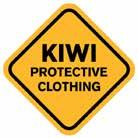




















Most have heard the phrase ‘the only constant is change,’ which is attributed to the ancient Greek philosopher, Heraclitus. While change might be the one constant in life since ancient times, another constant is the fear of change.
Those of us who have been long term know that most ministers have been fearful of making legal or policyrelated changes to improve are managed.
Stated another way, for simply haven’t been worth risking much political capital; best to avoid rocking the boat and focus on the more important portfolios. This risk-aversive sentiment drives public servant attitudes and behaviours.
The consequence for
largely based on guesswork, since little is known about what is caught or the effort expended, let alone knowledge about the value
yet, successive governments
have also failed to address tough problems confronting where tensions can escalate between competing sectors.
Notwithstanding that, for several years, worldwide there have been recognised needs to change the way managed, and improved data collection could drive those changes. To further that goal, several overseas jurisdictions have piloted reporting smartphone apps.
For example, since 2015, the US Federal Government has had grant programmes to support self-reporting app developments.
Collecting recreational catch and effort, social, and economic data that support transparent and participatory management and conservation is a key part of the National Saltwater Recreational Fisheries Policy.
More recently, the State of Victoria’s Fisheries Authority launched a recreational
The Victorian Fisheries Authority also endorses a statewide recreational
forum for identifying areas of agreement on strategic issues and facilitating policy options that assist the Authority to achieve its strategic vision.
In comparison, Fisheries
strategic vision, or policy,
sector, while its predecessor, the Ministry of Fisheries, abandoned the recreational sector forum approach decades ago.
To address this situation, in 2020 Fish Mainland developed the South Island Recreational Fisheries Policy nz This policy sets out 10 key principles, including management decision making that affects
ecological, social, cultural and economic information.
Fish Mainland has also worked with MPI’s Sustainable Food and Fibre Futures to secure funding to develop Mainland Catch, a smartphone app for South Island marine recreational
an intuitive and simple app designed by Fish Mainland and Fisheries New Zealand
and tested by South Island
Randall Besslinks to download Mainland Catch and videos on how easy it is to use.
The expansion of Mainland Catch into more recreational
though it can encounter technical challenges. If you encounter any problems, please contact us directly
to do their part in sustaining
limits and using Mainland Catch to record their catch and effort data and, therefore, contribute towards improved management decision making.
Finally, in the lead up to the 14 October general election, Fish Mainland will enquire about each political parties’ views on our policy’s proposed changes for
We will report back on what
We encourage you to show your support for Fish Mainland by becoming a member for free and making donations via our website or bank account no 03-0823-0101056-000.
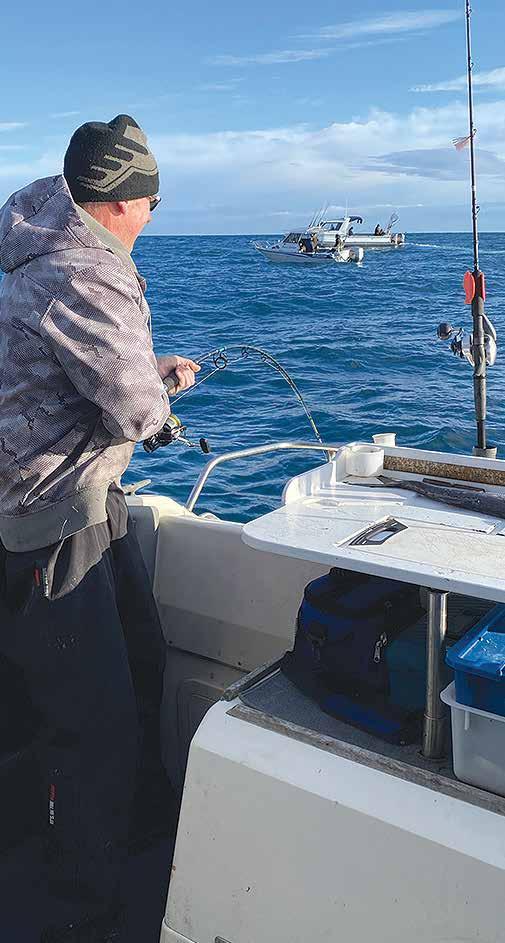

2 dozen oysters
3 eggs separated
Juice from small lemon
Zest from 1/2 lemon
Cracked pepper
Oil for shallow frying peaks form.
Beat egg yolks and add lemon pepper, whisking until a creamy batter forms.
Add oysters and then fold in the egg whites, combining lightly.
Heat oil over a moderate heat until it just starts to quiver on the surface. Shallow fry the oysters in batches until golden, turning once. This will only take a few moments, as over-cooking will cause the oyster to shrivel and
Place on absorbent paper and remove to a warming drawer until all oysters are cooked.

and we must deal with it, at least until after the election when, hopefully, a change of government occurs. Then as Nicole McKee and the ACT Party have promised—they will dump it!
The police have tried to make them out as being irresponsible, but this is a load of codswallop because holder, understands what give. Weigh this negligible return against the cost in both tax dollars and work hours—to say nothing of the risks to those who have it can be leaked or hacked. Sure, the police have said

they have done everything to make it safe, but their record of dropping the ball is astonishing.
So how well will it work?
Not well at all. Having registered cars sure as hell hasn’t stopped cars being stolen or used in ram-raids.
In my opinion, it’s all about control and knowing what when they decide to ban the
What are the chances the register is going to be kept up to date and accurate?
Not much. My pistols have been on a register for years and come inspection time it is never right, and we have under 5000 pistol endorsements in New

Zealand. Can you really see them being able to handle it when 240,000 people attempt to list all their
try and blame the licence holders if it doesn’t work or is not accurate.
The police say it’s needed because the gangs get most of their guns from licence holders. However, when COLFO put in an OIA
prove that at all. What it did highlight, was that the police do not know where the bulk
legally here must have a permit and is signed off on arrival. So, when the police

say they have no idea how is on them because they should know, based on past years’ records. Unless of course, guns have come in over the border and the gangs maybe… didn’t tell them? Like the drugs we don’t grow or manufacture— there is no shortage on the streets.
We once had a full register,
but it was dropped at the request of police in the 1980s. Their reasoning then was it was the wrong way to go and a waste of resources, as well as inaccurate. Like the register we’ve had for restricted guns is always out.
This new one is a complete waste of time. Think what good all that money could do in the hospitals or towards real police work
to stop crime getting worse every day. Like the ‘Buy Back Scheme’ that was in the interest of “Public
saw a massive increase in gang related shootings, this appears to be another rushed making the bureaucrats look good—but is it in the interest of public safety? I think not!
Sliders, also known as kaburas, are increasingly becoming a more popular
to see why. They are super easy to use, don’t require any messy bait and are very effective. Sliders appeal to snapper, gurnard, cod, the right places.
A slider has three basic moving parts, the lead head, a silicon skirt and the hook assist.
The head acts as the lure’s weight. The size of this is determined by a few
factors—namely depth, current and drift speed. As a rough rule; for calm relatively still conditions, go twice the depth in grams i.e. 80 grams in 40 metres of water and so on. If you’re drifting quickly, use a heavier weight. You want to go as light as you can in each situation. Using a lighter head allows better lure and skirt movement and, overall, this makes them more
attractor and is what makes a slider so effective. The light bits of silicon just waft
gently, bringing the slider to life in the water. Some
to their assist rig while others don’t and are packaged in their individual components. To rig up the individual components, simply take your trace, run it through the hole in the head, through the to the metal ring attached to the assist hooks. This allows the head to swing free of the hooks and the skirt, hence the name slider. This allows the skirt to have a good action and it lets the head


throw the hooks.
The assist hooks are the business end of the whole rig. While the hooks are small and light, they’re super strong and capable of Having light hooks allows the skirt to move more freely and lets the hooks sit up amongst the skirt in prime position.
Fishing a slider is pretty
simple. Just drop it over the side and let it sink to the bottom. The most basic action is a super slow wind up a few metres off the are around midwater, then drop and repeat. If the bottom a slow lift and drop works well. The secret is not
slow as possible.
Slider set up
When you feel a bite do not strike, just a slow lift or wind is all it takes to set the super sharp hooks in place. Then just take your time to being carful not to pull too hard and risk ripping the
Sliders are a fun alternative to bait, a great way to mix something different.

$195,000 Land Yourself This Fully Relocatable Business For Fishing And Hunting Enthusiasts
Pāua is one of New Zealand’s most iconic and popular fisheries. Most are familiar with the regulations around pāua harvesting –bag limits ranging from 2 to 10 per person per day (depending on location), and the minimum legal size of 125mm around the whole country (with regional exceptions of 85mm in Taranaki, and recently 135mm in the Oaro-Haumuri Taiāpure south of Kaikoura).
Minimum legal size (MLS) is one of the most widely implemented fisheries management tools. It ensures that animals can reach maturity, and then remain for enough spawning seasons to enable su cient reproduction to sustain populations. The underlying rationale for setting the size limit for pāua at 125mm is uncertain, although studies from the 1980s indicate that this was deemed appropriate based on yield-per-recruit modelling to sustain fisheries at the time (based on data from the Kaikōura and Banks Peninsula area) (Sainsbury, 1982). The rule of thumb for setting MLS in abalone fisheries is often described as the “2-year rule”; that abalone should be allowed to reach maturity, and then grow for two years during which they can contribute to spawning (although recent best practise now leans towards 3-4 years). This means that the size at which pāua reach maturity, and annual growth increments after this are two critical biological parameters to be considered with the setting of MLS.
However, it is well documented that pāua exhibit geographic variability in both length at maturity and growth rates around New Zealand. With specific regard to growth, pāua from warmer northern waters tend to grow slower than pāua from cooler southern waters, although growth
is also influenced by other factors such as food availability, wave exposure and other habitat related factors. This means that the ‘one size fits all’ size limit of 125mm for pāua across most of New Zealand is inappropriate, as it is likely too big in some northern areas, and too small in the faster growing areas of the south to adequately protect spawning biomass and sustain populations.
Most will be aware of the exception to the 125mm MLS in the Taranaki Region where the MLS was lowered to 85mm in 2013 and there has been a recent increase to 135mm in the OaroHaumuri Taiāpure area of the Kaikōura coastline to reflect the biological characteristics of these populations.
However, large parts of the fishery are still able to be harvested at an MLS which is most likely inappropriate for specific regions.
In the commercial fishery, the variation in biological characteristics of pāua populations at di erent scales is recognised in the implementation of variable minimum harvest sizes (MHS) across most of the fishery. Up to 5 di erent MHS are implemented in some of the pāua QMAs up to as large as 145mm on the East Coast of Marlborough.
The primary benefit of increased harvest size is that is leaves pāua in the water for long enough to reproduce to sustain populations by protecting a larger proportion of the spawning biomass before it is susceptible to harvest. Another equally important benefit is that protection of a larger proportion of the spawning biomass allows for higher potential for the creation of ‘spawning aggregations’ which are


critical for successful recruitment. Pāua are broadcast spawners, meaning males and females release sperm and eggs into the water column synchronously, after which fertilisation, and larval development and dispersal occurs before juvenile settlement. For successful fertilisation, it is critical that mature males and females are in close enough proximity, which is enhanced by protecting a larger proportion of the spawning biomass with larger MLS.
Despite the well documented evidence for the appropriateness of multiple MLS around New Zealand to responsibly manage our pāua fisheries, as well as the intuitively obvious sustainability benefits, there are several arguments against changes to MLS in paua fisheries that are often raised.
One of the most common arguments is that increasing the MLS will then increase the fishing pressure on larger pāua which have the largest reproductive potential. It is true that in pāua, like many other fisheries species, that fecundity (measured by the number of eggs produced by a mature female)
increases significantly with the size of the animal. There is evidence from studies undertaken in the 1970s that shows pāua egg production increases exponentially with shell length, with the possibility that this may decrease after a certain size of about 150mm (Poore, 1973). However, another important consideration for reproductive success is also the egg quality, which may deteriorate in older and larger pāua. While there is no scientific evidence to show this, we know anecdotally from experts who spawn pāua for aquaculture purposes, that pāua in the size range of 125-135mm have the highest spawning success rates.
This suggests that pāua in these size ranges possibly have the highest reproductive potential and make the most meaningful contributions to recruitment.
If this is the case, it further supports the argument that increasing MLS in some populations will have significant positive benefits for population sustainability. Also, as mentioned earlier, proximity of spawning adults


(‘spawning aggregations’) is also critical for reproductive potential, and can be significantly enhanced by increasing MLS. This is a specific area that we are currently interested in researching further to make decisions with greater scientific certainty.
Even in the case where the largest pāua do have the highest reproductive potential, increasing MLS will not have a material e ect on the numbers of large pāua harvested. Compare this to the snapper fishery, where the release of large snapper is encouraged due to their high fecundity as well as the ecological role that large snapper play in their ecosystems – pāua are not a catch and release fishery, and harvesting large pāua is not avoided under the same conservation principles. To the contrary, divers will usually target the largest pāua they can find and even high-grade catches to maximise the feed they can take home.
Another commonly raised argument against increasing MLS is that it will increase the rate of incidental mortality as harvesters have to adjust to catching pāua at larger sizes. Incidental mortality is a valid concern with pāua, as returning undersized pāua can result in mortality if they are injured during harvesting. However, it does not take much to ‘get your eye in’ as you are harvesting to be sure that you are only removing pāua over the relevant MLS, after which the rate of incidental mortality becomes constant no matter what the MLS is. The key messaging here is to ensure that harvesters use the right tools and techniques during harvesting to reduce the rate of injury to undersized pāua, specifically: using blunt tools such as the Fisheries New Zealand pāua
tool, approaching pāua from the back to dislodge them (away from the pointy end where the head and vital organs are concentrated), and to leave pāua alone once they are disturbed and strongly fix themselves to the bottom.
Variable MLS also require the need for di erent measuring tools to be used and an awareness of regional regulations and can introduce a layer of complexity for enforcement in some specific cases. While this can be an adjustment, there are multiple species around New Zealand where di erent sizes limits exist in di erent regions (e.g., Snapper) where the inconvenience of needing multiple measures and enforcement di culties are not an issue.
Another benefit for the diver harvesting pāua at a larger MLS is the yield of meat that comes from pāua harvested. The meat weight of a 125mm pāua is 125g and from a (for example) 135mm pāua is 160g, which is almost a 30% increase in what ends up on the table, regardless of how many you take.
Despite the adjustments that have to be made for all when MLS changes, any inconveniences and arguments against are far outweighed by the overall sustainability benefits that arise from protecting a larger proportion of the spawning biomass, allowing longer for pāua to spawn, and significantly enhancing the opportunity for mature pāua to form spawning aggregations. Forward thinking and regional based management that recognises the di erent biological characteristics of this iconic species in di erent regions is essential to its long-term sustainability,
I’ll start off by apologising for sounding like a broken record. Apologies also to the generation that has absolutely no idea what a broken record is, but I’m going to carry on from the back end of last month’s Cut. We’ve got a huge problem in this country.
It’s called lawlessness and it’s getting worse day by day. We have a community sector that has absolutely no respect for the law or any kind of authority whatsoever.
Thirty years ago when I wore a blue uniform, the criminals had, if not respect for the police, an element of fear for them— even though very few would admit it.
I can remember turning up at street brawls and having the participants scatter, especially when a police dog was deployed. I can remember burglars, thieves and assailants after their second or third offence being given a prison sentence. I can’t, however, remember kids stealing cars and using them to batter their way into shops. I also can’t remember a funeral where streets were blocked, burnouts were permitted and where vehicle passengers were allowed to sit half out of car windows and abuse innocent motorists who had the audacity to be on the road at the same time. I certainly can’t remember a prime minister and the opposition leader, having rightfully spoken out against gangs, being told on national television by the leader of Te Pati Maori, Rawiri Waititi, to
then attempted a Will Smith impersonation with the comment, “Keep my iwi out
he’s gone back and watched that clip and realised how bloody ridiculous he looked and sounded. You sure ain’t no Will Smith Mr Waititi. When we have an elected member of parliament encouraging lawless behaviour and being able to get away with it, yep, we do have a problem.
Unfortunately for a large sector of the population, this lawlessness is allowed to carry on and get worse, with our police seemingly powerless to stop it.
Quite a few years ago, the Ureweras ceased to be a National Park and was handed to DoC and Tuhoi to co-govern. It didn’t take long for DoC to become almost invisible and let Tuhoi run the place. Some will say fair enough, it was and they won’t get too many arguments from me there. Having said that, Tuhoi are issuing permits but there are reports of permit holders being threatened. Yet I haven’t heard of any arrests following.
A couple of weeks ago I
in 49 years. I broke the law, got caught and have paid the price by way of a $120
a registered and warranted vehicle and don’t wear a patch. I was an easy, safe target for the young constable, wasn’t I?


The times they are a-changin' Sinker
Ron Prestage

’’In 1964 Bob Dylan’s song, ‘The Times They Are A-Changin’,’ aptly described today know about, as they experience a changing Zealand, brought about by climate change.
experienced lengthy snapper seasons over recent years,
with snapper being caught in good numbers well into June. Increased water temperatures have expanded spawning opportunities and driven a southerly range expansion.
This southerly range expansion of the snapper on the South Island’s West Coast, where impressive catches of snapper have been reported south of Hokitika.
The albacore tuna seasonal affected by climate change in the form of increased water temperature, altered wind patterns and ocean researchers are busy in this space.
At this stage climate change
constant, the future may be
problematical with changes on land leading to increased sedimentation and turbidity at sea.
